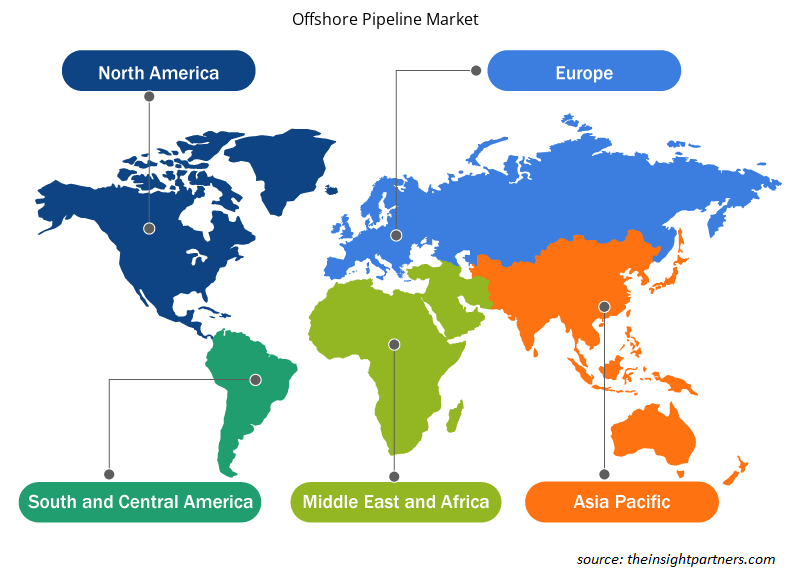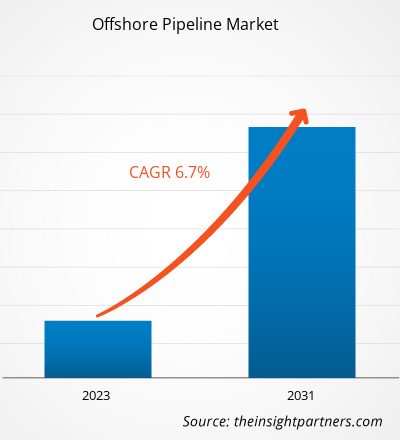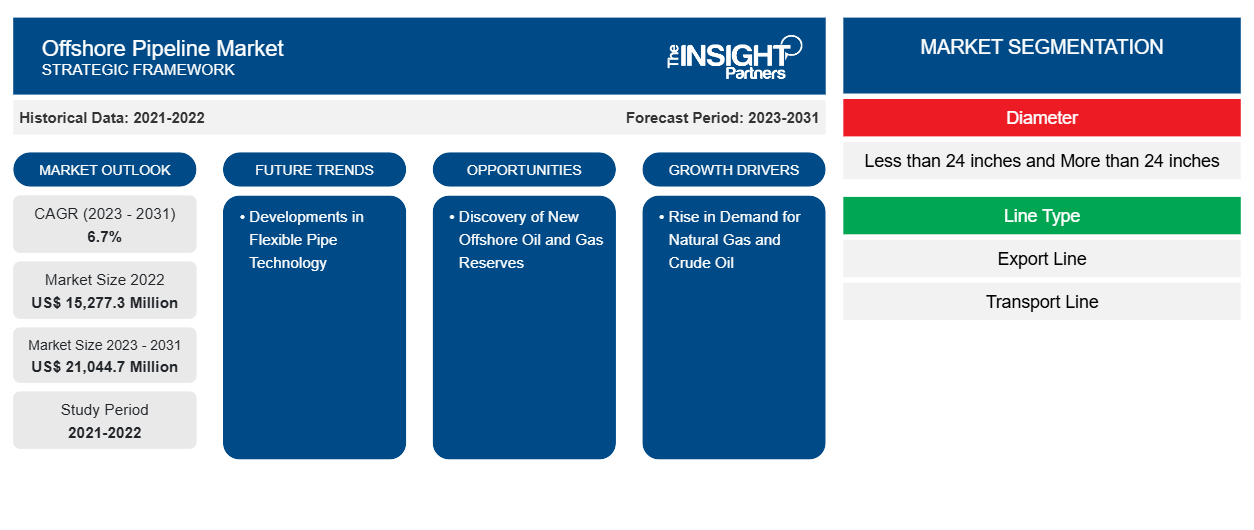Si prevede che la dimensione del mercato delle condotte offshore raggiungerà i 21.044,7 milioni di dollari entro il 2031, rispetto ai 15.277,3 milioni di dollari del 2022. Si prevede che il mercato registrerà un CAGR del 6,7% nel periodo 2023-2031. L'aumento della produzione di petrolio e gas offshore, la crescente produzione di nuove piattaforme petrolifere e la ricostruzione di piattaforme petrolifere e gas offshore esistenti e vecchie sono tra i fattori chiave che guidano il mercato delle condotte offshore.
Analisi del mercato delle condotte offshore
Si prevede che il mercato delle condotte offshore registrerà una crescita considerevole a causa del crescente numero di progetti di gas naturale e della scoperta di nuovi giacimenti petroliferi, in particolare in località remote. Inoltre, l'esaurimento delle riserve di petrolio e gas esistenti in vari paesi ha creato una domanda di condotte transfrontaliere per la fornitura di prodotti correlati a petrolio e gas, il che sta stimolando la crescita del mercato delle condotte offshore. La crescente domanda di metodi di trasporto convenienti per petrolio e gas è anche uno dei principali fattori che dovrebbero stimolare la domanda di condotte offshore nel settore petrolifero e del gas in tutto il mondo.
Panoramica del mercato delle condotte offshore
L'esplosione demografica e la corrispondente industrializzazione hanno innescato la domanda di energia a livello globale. L'aumento del consumo di energia ha aumentato la necessità di petrolio e gas nelle economie in via di sviluppo e sviluppate. Ha portato a una spinta della domanda di infrastrutture di condotte offshore in tutto il mondo. L'Asia Pacifica è il più grande consumatore di petrolio greggio e gas. Inoltre, i paesi altamente industrializzati dell'Asia Pacifica, tra cui Cina, India, Giappone e Corea del Sud, stanno segnalando un aumento del consumo energetico complessivo. La loro attenzione all'aumento della produzione nazionale di petrolio attraverso varie tecniche di recupero del petrolio avanzato sta promuovendo il mercato delle condotte offshore nell'Asia Pacifica per soddisfare la crescente domanda di petrolio.
Personalizza questo report in base alle tue esigenze
Riceverai la personalizzazione gratuita di qualsiasi report, comprese parti di questo report, o analisi a livello nazionale, pacchetto dati Excel, oltre a usufruire di grandi offerte e sconti per start-up e università
-
Scopri le principali tendenze di mercato in questo rapporto.Questo campione GRATUITO includerà analisi di dati che spaziano dalle tendenze di mercato alle stime e alle previsioni.
Driver e opportunità del mercato delle condotte offshore
Aumento della domanda di gas naturale e petrolio greggio
La domanda di petrolio e gas naturale sta assistendo a un aumento costante in tutto il mondo. Gli Stati Uniti e la Cina hanno registrato la crescita più evidente. L'impennata della produzione industriale, insieme all'elevata domanda di servizi di autotrasporto, sta aumentando la domanda di prodotti petrolchimici, alimentando così la crescita del mercato delle condotte offshore. Inoltre, la crescita dei volumi di traffico aereo in tutto il mondo, in particolare in Asia, è un altro fattore significativo che determina un aumento del consumo di petrolio.fuelling the growth of the offshore pipeline market. Moreover, the growth in air traffic volumes worldwide, particularly in Asia, is another significant factor resulting in increased oil consumption.
L'Organizzazione dei Paesi esportatori di petrolio (OPEC) ha pubblicato "The 2020 OPEC World Oil Outlook" nell'ottobre 2020. Secondo le previsioni, la pandemia di COVID-19 ha portato a un calo della domanda di petrolio; tuttavia, ci si aspettava che la domanda globale di energia avrebbe registrato una crescita costante in futuro, aumentando di un notevole 25% entro il 2045. Le previsioni prevedono inoltre che il petrolio sarà il principale contributore nel mercato del mix energetico, contribuendo al 27% della quota energetica complessiva entro il 2045. Si stima che la domanda di prodotti petroliferi aumenterà di oltre ~47 Mb/giorno nel periodo 2022-2025 nei Paesi OCSE. D'altro canto, si prevede che la domanda nei Paesi non OCSE aumenterà di 22,5 MB/giorno durante il periodo di previsione.OECD countries. On the other hand, the demand in non-OECD countries is projected to rise by 22.5 MB/day during the forecast period.
Sforzi costanti per migliorare le operazioni di recupero del petrolio
Diversi paesi stanno investendo nel ringiovanimento delle loro risorse petrolifere esistenti per aumentare la produzione nazionale di petrolio e ridurre la loro dipendenza dalle importazioni di petrolio. Negli ultimi decenni, il metodo di iniezione di vapore è stato sfruttato commercialmente per migliorare il recupero dai giacimenti convenzionali di petrolio pesante nelle loro fasi successive di sviluppo. Il vapore iniettato aumenta la pressione complessiva di un giacimento petrolifero offshore, il che aiuta a migliorare il rapporto di mobilità del petrolio greggio e gli consente di fluire in modo efficiente. Di conseguenza, i metodi di recupero del petrolio migliorati aiutano a rivitalizzare i processi di estrazione nei pozzi petroliferi offshore esistenti. Pertanto, si prevede che l'espansione delle operazioni di petrolio e gas offrirà promettenti opportunità di crescita agli operatori del mercato degli oleodotti offshore nei prossimi anni.
Analisi della segmentazione del rapporto sul mercato delle condotte offshore
I segmenti chiave che hanno contribuito alla derivazione dell'analisi di mercato delle condotte offshore sono la tipologia e l'utente finale.
- In base al diametro, il mercato delle condotte offshore è stato suddiviso in meno di 24 pollici e più di 24 pollici. Il segmento inferiore a 24 pollici ha detenuto una quota di mercato maggiore nel 2023.
- Per tipo di linea, il mercato delle condotte offshore è segmentato in linee di trasporto, linee di esportazione e altre. Il segmento delle linee di trasporto ha detenuto la quota di mercato maggiore nel 2023.
- In termini di prodotti, il mercato è segmentato in petrolio, gas e prodotti raffinati. Il segmento dei prodotti raffinati ha dominato il mercato nel 2023.
Analisi della quota di mercato delle condotte offshore per area geografica
L'ambito geografico del rapporto sul mercato delle condotte offshore è suddiviso principalmente in cinque regioni: Nord America, Europa, Asia Pacifico, Medio Oriente e Africa, Sud e Centro America.
L'Europa ha dominato il mercato delle condotte offshore nel 2023. Il mercato in Europa è segmentato in Germania, Norvegia, Italia, Russia, Regno Unito e resto d'Europa. L'Europa è il secondo produttore mondiale di prodotti petroliferi, con una capacità di raffinazione del petrolio superiore al 15%. L'industria del gas in Europa ha osservato vari cambiamenti dovuti alla crescente domanda di GNL. Inoltre, Norvegia e Russia mantengono ancora la loro posizione di fornitori di gas naturale, mentre Germania, Francia e Italia sono i principali importatori di gas naturale. Pertanto, il crescente numero di progetti di gas naturale, nonché la scoperta di nuovi giacimenti petroliferi, in particolare in località remote, accelereranno molto probabilmente la domanda di sistemi e servizi di condotte offshore.
Approfondimenti regionali sul mercato dei gasdotti offshore
Le tendenze regionali e i fattori che influenzano il mercato delle condotte offshore durante il periodo di previsione sono stati ampiamente spiegati dagli analisti di Insight Partners. Questa sezione discute anche i segmenti e la geografia del mercato delle condotte offshore in Nord America, Europa, Asia Pacifico, Medio Oriente e Africa e America meridionale e centrale.

- Ottieni i dati specifici regionali per il mercato dei gasdotti offshore
Ambito del rapporto sul mercato delle condotte offshore
| Attributo del report | Dettagli |
|---|---|
| Dimensioni del mercato nel 2022 | 15.277,3 milioni di dollari USA |
| Dimensioni del mercato entro il 2031 | 21.044,7 milioni di dollari USA |
| CAGR globale (2023-2031) | 6,7% |
| Dati storici | 2021-2022 |
| Periodo di previsione | 2023-2031 |
| Segmenti coperti |
Per diametro
|
| Regioni e Paesi coperti |
America del Nord
|
| Leader di mercato e profili aziendali chiave |
|
Densità degli operatori del mercato delle condotte offshore: comprendere il suo impatto sulle dinamiche aziendali
Il mercato Offshore Pipeline Market sta crescendo rapidamente, spinto dalla crescente domanda degli utenti finali dovuta a fattori quali l'evoluzione delle preferenze dei consumatori, i progressi tecnologici e una maggiore consapevolezza dei vantaggi del prodotto. Con l'aumento della domanda, le aziende stanno ampliando le loro offerte, innovando per soddisfare le esigenze dei consumatori e capitalizzando sulle tendenze emergenti, il che alimenta ulteriormente la crescita del mercato.
La densità degli operatori di mercato si riferisce alla distribuzione di aziende o società che operano in un particolare mercato o settore. Indica quanti concorrenti (operatori di mercato) sono presenti in un dato spazio di mercato in relazione alle sue dimensioni o al valore di mercato totale.
Le principali aziende che operano nel mercato delle condotte offshore sono:
- Enbridge Inc
- Saipem SpA
- Società anonima McDermott International Ltd.
- Gruppo Allseas SA
- Ingegneria delle condotte petrolifere cinesi Ltd
- Kinder Morgan
Disclaimer : le aziende elencate sopra non sono classificate secondo un ordine particolare.

- Ottieni una panoramica dei principali attori del mercato delle condotte offshore
Notizie e sviluppi recenti sul mercato delle condotte offshore
Il mercato delle condotte offshore viene valutato raccogliendo dati qualitativi e quantitativi dopo la ricerca primaria e secondaria, che include importanti pubblicazioni aziendali, dati associativi e database. Di seguito sono elencati alcuni degli sviluppi nel mercato delle condotte offshore:
- Nel luglio 2023, Kinder Morgan e Howard Energy Partners hanno ampliato i loro sistemi di trasporto del gas naturale Eagle Ford. Tejas sta costruendo un gasdotto di 67 miglia e Dos Caminos sta costruendo un gasdotto di 62 miglia. Si prevede che i progetti saranno completati nel quarto trimestre del 2023 e forniranno fino a 2 miliardi di piedi cubi/giorno di gas naturale ai mercati della costa del Golfo degli Stati Uniti. Il progetto di espansione da 251 milioni di dollari USA è un collegamento di fornitura fondamentale per generatori di energia , clienti industriali ed esportatori di GNL lungo la rete di gasdotti intrastatali del Texas.
- Nel febbraio 2023, Enagas ha firmato un accordo con Reganosa in cui Enagas ha pagato 54 milioni di euro a Reganosa per l'acquisto di una rete di 130 km di gasdotti di gas naturale. L'efficiente funzionamento e la sicurezza dell'approvvigionamento del mercato del gas iberico dipendono da questa rete.
Copertura e risultati del rapporto sul mercato delle condotte offshore
Il rapporto “Dimensioni e previsioni del mercato delle condotte offshore (2021-2031)” fornisce un’analisi dettagliata del mercato che copre le seguenti aree:
- Dimensioni e previsioni del mercato delle condotte offshore a livello globale, regionale e nazionale per tutti i segmenti di mercato chiave coperti dall'ambito
- Tendenze del mercato delle condotte offshore e dinamiche di mercato quali fattori trainanti, vincoli e opportunità chiave
- Analisi dettagliata delle cinque forze PEST/Porter e SWOT
- Analisi del mercato delle condotte offshore che copre le principali tendenze del mercato, il quadro globale e regionale, i principali attori, le normative e i recenti sviluppi del mercato
- Analisi del panorama industriale e della concorrenza che copre la concentrazione del mercato, l'analisi della mappa di calore, i principali attori e gli sviluppi recenti per il mercato delle condotte offshore
- Profili aziendali dettagliati
- Analisi storica (2 anni), anno base, previsione (7 anni) con CAGR
- Analisi PEST e SWOT
- Valore/volume delle dimensioni del mercato - Globale, Regionale, Nazionale
- Industria e panorama competitivo
- Set di dati Excel
Report recenti
Testimonianze
Motivo dell'acquisto
- Processo decisionale informato
- Comprensione delle dinamiche di mercato
- Analisi competitiva
- Analisi dei clienti
- Previsioni di mercato
- Mitigazione del rischio
- Pianificazione strategica
- Giustificazione degli investimenti
- Identificazione dei mercati emergenti
- Miglioramento delle strategie di marketing
- Aumento dell'efficienza operativa
- Allineamento alle tendenze normative























 Ottieni un campione gratuito per - Mercato dei gasdotti offshore
Ottieni un campione gratuito per - Mercato dei gasdotti offshore